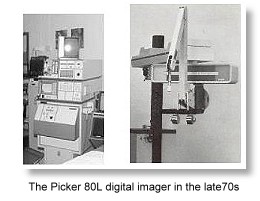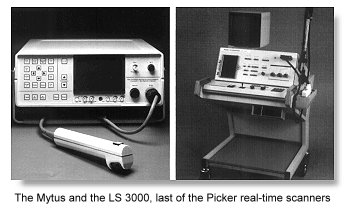About Picker International and some history of American scanner companies
During the 1960s and 1970s, the number of imaging equipment manufacturers further grew. By the mid-1970s, the U.S. market alone was being served by more than 100 manufacturers. In the U.S., the leaders remained the same, with General Electric, Picker, Philips, Siemens, and the Westinghouse system controlling about 70% of the American radiology market in the mid-1970s.
In Denver, Colorado in the early 1960s, Douglas Howry and Joseph Homles, together with engineers Gerald Posakony, William Wright and Ralph Meyerdink, came up with a prototype multi-joint compound contact scanner where the transducer could be positioned and moved over the scanning area by the operator. In 1962, Wright and Meyerdink left the University to form the Physionics Engineering Inc. at Longmont, Colorado, and the first commercially available, hand-held articulated arm (with position mechanisms at each joint ) compound contact scanner was produced in the United States. Physionics was acquired by the Picker Corporation.
In 1981, Picker was acquired by General Electric Co. Ltd. of England (GEC). Picker merged with Cambridge Instruments, GEC Medical, and American Optical to form Picker International. In the 70's and early 80's Picker International became a very strong producer of gray-scale static B-mode ultrasound scanners. As the real-time scanners replaced the static scanners in the early to mid-80s, Picker did not pursue its own product line. In 1982, Picker entered into a sales relationship with Universal Medical Systems, a distributer of ultrasound equipment to sell the portable Ausonics (Mytus) ultrasound mechanical sector scanner under the Picker label. The company was also selling Hitachi /Ecoscan EUB range of linear array products from Japan under the Picker label. These were the last of Picker's marketed ultrasound products.
During the early 1950s, there were perhaps 100 radiological equipment manufacturers in the world, with about 40 selling equipment in the United States. Most developed countries had one or more strong national xPalatino-ray and electromedical equipment manufacturers, with a few of those firms serving international markets. In the U.S., the leaders were General Electric, Picker X-Ray, and Westinghouse. Several small specialists, including Continental X-Ray, Profexray, and Standard X-Ray held significant positions. The European firms Philips and Siemens had strong positions in their home markets and smaller, but notable, positions in the United States. Other national leaders included CGR in France; Hitachi, Shimadzu, and Tokyo Shibaura (Toshiba) in Japan; and GEC in the United Kingdom.
 Picker, an X-ray equipment specialist was founded by James Picker in New York City in 1915, offering sales and service of X-ray equipment, film and accessories. The James Picker company was acquired by a financial services company, CIT Financial, in 1958. In 1967, the company changed its name from Picker X-ray to Picker Corporation. In the same year Picker acquired Dunlee Corporation, a company in Chicago founded by Dunmore Dunk and Zed Atlee to meet demand for quality X-ray tubes and special purpose tubes.
Picker was an important innovator in the nuclear and ultrasonic imaging fields during the 1960s, being the first of the major American x-ray equipment producers to enter the new product areas. Although members of the Picker family continued to manage the medical equipment subsidiary, the senior members were reaching retirement age during the mid-1970s.
Picker, an X-ray equipment specialist was founded by James Picker in New York City in 1915, offering sales and service of X-ray equipment, film and accessories. The James Picker company was acquired by a financial services company, CIT Financial, in 1958. In 1967, the company changed its name from Picker X-ray to Picker Corporation. In the same year Picker acquired Dunlee Corporation, a company in Chicago founded by Dunmore Dunk and Zed Atlee to meet demand for quality X-ray tubes and special purpose tubes.
Picker was an important innovator in the nuclear and ultrasonic imaging fields during the 1960s, being the first of the major American x-ray equipment producers to enter the new product areas. Although members of the Picker family continued to manage the medical equipment subsidiary, the senior members were reaching retirement age during the mid-1970s.

In the same year Picker International moved away from ultrasound completely and ending its 20 plus years of leadership in the ultrasound field. In 1986, the company produced the industry's first 1.0T MR imager. In 1998, Picker acquired the Computed Tomography Division of Elscint Ltd., immediately positioning the company at the forefront of major global CT suppliers. In 1999, the company unveils the new Marconi Medical Systems name and corporate vision. In 2001, Philips acquired Marconi Medical Systems.
A gallery of Picker's older scanners can be found here.
The other big x-ray manufacturer, Westinghouse x-ray operations were acquired by the experienced French radiology equipment firm, CGR, in 1971. Subsequently, CGR was acquired by the diversified French company, Thomson, in 1975. Partly supported by government-supported preferential buying, CGR had long been successful in France, where it had operated since before World War II. However, it had not been able to acquire a significant market share beyond the French borders. Its acquisition of the Westinghouse x-ray operations in 1971 was intended to give it strength in the U.S., but that strength had not yet developed. By 1979, CGR had tried to enter the ultrasonic imaging subfields of the industry, using the resources of its new parent, Thomson, to finance development programs for products in those fields.
A few new players also had some success in the United States. Litton had a strong x-ray position, built on its acquisition of Profexray in 1964. The drug company, G.D. Searle, had become an important player in nuclear medical imaging via its acquisition of the nuclear imaging innovator Nuclear Chicago in 1966, and also an important innovator in ultrasound in the mid-1975s, producing one of the earliest commercial static scanners with digital scan converters. A financial services firm, Boston Capital Corporation had turned into a nuclear and ultrasonic imaging equipment manufacturing specialist, Technicare, by acquiring two innovative startup companies during the early 1970s.
Several firms without imaging system experience had used computed tomography and ultrasound as their entry point into the industry, with GE, Pfizer, Syntex, and Varian being among the most notable. Although based in the United States, the three firms also sold equipment in Europe and Japan, using local medical equipment manufacturers and distributors.
Litton was a strong aerospace firm that entered the imaging industry as part of a diversification spree during the 1960s. It attained a secondary leadership position in the conventional x-ray field and used its distribution system to handle Toshiba's ultrasound and nuclear lines. But Litton's attempt to introduce its own nuclear and ultrasonic imaging devices had been unsuccessful in the market, although one of the company's ultrasonic technical advances had been quickly adopted by its competitors. During 1977 it was carrying out active negotiations with an x-ray innovator, Xonics, with the goal of divesting its imaging lines.
Similar to Searle, Technicare was a non-x-ray imaging specialist. The firm was profitable, but its financial base was smaller than those of its large competitors. Once a financial services firm, the Boston Capital Corporation, the company had acquired an nuclear imaging innovator, the Ohio-Nuclear, Inc. in 1971and changed its name to Technicare. Continuing to innovate, it had quickly become a major player in that subfield. In 1975, Technicare acquired an ultrasound equipment innovator and had some success in that field. The company had strong but narrow in-house electronics capabilities, primarily focused on a few key people. The company had entered the CT market by drawing on its knowledge of nuclear imaging data processing. Its second generation design, which it had brought from idea to commercial prototype in less than a year, was a quick success. By early 1978, though, the system was under pressure from the third and fourth generation products being introduced by other entrants and Technicare was rushing a third-generation system of its own through research and development stages. Technicare also markets the Aloka line of ultrasound products from Japan. Technicare was acquired by Johnson & Johnson in 1979. Johnson & Johnson sold Technicare to General Electric in 1986.
Varian is a California electronics equipment manufacturer. Long a producer of x-ray tubes, the company saw innovative CT and ultrasound imaging equipment as an entry point into the systems market. Varian produced one of the earliest designs in mechanical sector transducers for cardiac investigations. After acquiring rights to new Stanford University research and the patents previously held by Syntex, Varian introduced an early third-generation CT system. About the same time, the company also began a technically advanced ultrasonic scanner development project. By 1977, however, it was clear that the Varian CT system had technical problems and that the company had no visibility in the user market. Its ultrasound equipment also was not able to pentrate much of the market.
Back to History of Ultrasound in Obstetrics and Gynecology.